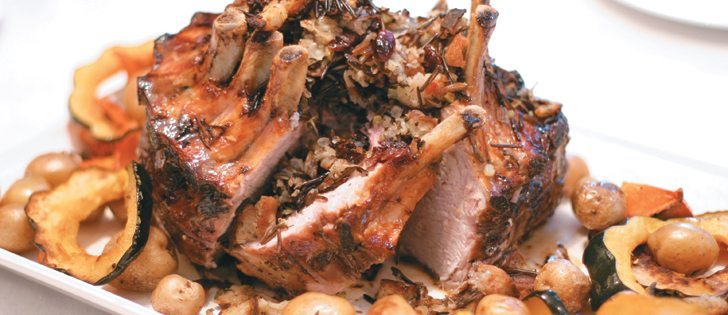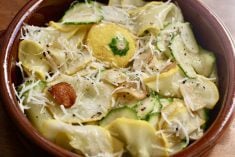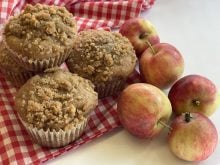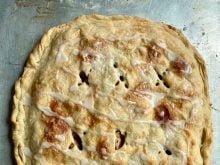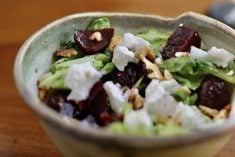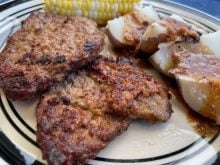A crown roast of pork is a regular bone-in pork loin that makes an elegant entree for special occasions like Easter. Order it in advance from your butcher shop and ask for it to be frenched and tied.
Frenched means that the bone tips are cleaned of all meat and fat. Roasts of less than 12 ribs are difficult to form into a crown so this is usually a meal for at least eight to 10 people. Allow one and a half ribs per person or more if you want leftovers.
Read Also

Sustainable food has ‘lost all meaning’: prof
That marketing strategy is deader than a doornail, says a University of Guelph professor who specializes in consumer preferences and perceptions of agriculture and food.
Pavlova is a meringue based dessert named for Russian ballerina Anna Pavlova. It was created either in Australia or New Zealand after one of her tours in the 1920s.
It can be one large meringue base to serve everyone or made into individual small meringues for individual desserts. Pavlova impresses no matter how you serve it.
Crown Roast of Pork
Preheat oven to 325 F (160 C).
Roast for up to an hour for a small roast and up to two hours for a roast over 10 pounds (4.5 kg). Remove from oven, remove ball of foil and fill cavity with stuffing. Cover stuffing loosely with kitchen foil. Return to oven and roast until an internal temperature of 155 F (68 C) is reached. Measure the temperature by inserting a meat thermometer into a thick portion of the meat without touching a bone.
Remove foil from bone tips and stuffing about 30 minutes before roast is fully cooked.
At this time if you find that the roast is not browning as much as you like, brush it with the caramelized juices from the bottom of the roasting pan and increase oven temperature to 475 F (245 C).
When internal temperature is reached, remove from oven and tent with kitchen foil. Rest for 10 minutes. The temperature will continue to rise a few degrees while it is resting. Pork is fully cooked at 160 F (71 C).
The rule of thumb for total roasting time is 10-15 minutes per pound.
Slice between each bone to serve. Source: Adapted from Put Pork on Your Fork.
Wild Rice and Bread Stuffing
- 1 c. of cooked, drained wild rice (1/3 cup or 80 mL raw) 250 mL
- 1/4 c. celery, finely diced 60 mL
- 1/4 c. onion, finely diced 60 mL
- 3 tbsp. butter 45 mL
- salt and pepper, to taste
- 1/2 tsp. dried sage 2 mL
- 1/2 tsp. dried thyme 2 mL
- 1 c. day old bread cubes 250 mL
- 1/2 c. dried cranberries 125 mL
- 1/4 c. chicken or 60 mL
- mushroom stock
Plump dried cranberries in 1/2 cup (125 mL) of hot water for 15 minutes. Drain and set aside.
Saute celery and onion in butter until translucent. Add seasonings, dried cranberries and bread. Remove from heat. Stir to mix and add stock.
Oven Roasted Vegetables
- carrots
- baby potatoes
- butternut squash
- cooking oil
- coarse salt and freshly ground black pepper
Preheat oven to 325 F (160 C). Wash baby potatoes and slice larger ones in half. All pieces should be about the same size. Peel and cut carrots into same size pieces as potatoes. Slice squash into rings and scoop out the seeds. Do not peel squash. It will hold its shape better if left unpeeled.
Pat dry and toss all vegetables in enough cooking oil to lightly coat and arrange on an ungreased baking sheet.
Generously season with coarse salt and freshly ground black pepper. Roast in preheated oven until tender, about 20 minutes.
Stir occasionally, if necessary, but it is ideal to have some browning.
Brown Sugar Pavlova with Seasonal Fruit and Berries
Meringue
- 1 c. granulated sugar 250 mL
- 1/2 c. packed light brown sugar 125 mL
- 1 1/2 tbsp. cornstarch 20 mL
- 1 1/2 tsp. pure vanilla extract 7 mL
- 2 tsp. white vinegar 10 mL
- 3/4 c. egg whites (from 5 to 6 large eggs) at room temperature for 30 minutes 185 mL
Topping
- 4 c. selection of seasonal fruits or berries 1 L
- 2 tbsp. granulated sugar 30 mL
Cream
- 1 c. chilled heavy cream 250 mL
- 1/3 c. chilled sour cream 80 mL
Preheat oven to 250 F (120 C) with rack in middle. Line a baking sheet with parchment paper.
Pulse sugar, brown sugar and cornstarch in a food processor until well combined. Pass through a sieve to remove any lumps.
Stir together vanilla and vinegar in a small bowl.
Add vinegar mixture, then beat at high speed until meringue is glossy and holds stiff peaks, about five minutes. Using a piping bag, make individual pavlovas about four inches (10 cm) in diameter or make two large ones. Start piping from the centre and work outwards.
Or you can simply use a large spoon and smooth it into a round. Make the outer edge higher than the inside whether piping or spooning.
Bake until meringues have a crisp crust and feel dry to the touch, about one hour. The inside will be marsh-mallow like. Turn oven off and prop door open slightly. Cool meringue in oven for one hour. Meringue may sink slightly and crack while cooling.
When completely cool, carefully peel off parchment. Meringue will be fragile and the crust may crack further. This can be used the same day or stored in an airtight container at room temperature for up to three days. Meringues can also be frozen in airtight packaging up to three months.
Toss fruit or berries with sugar and let stand at room temperature until ready to use, up to one hour.
Beat cream with sour cream using an electric mixer until it just holds soft peaks. To serve, put each meringue on a serving plate and spread with whipped cream. Top with fruit and juice from fruit. Serves 10-12.
Sarah Galvin is a home economist, teacher and farmers’ market vendor at Swift Current, Sask., and a member of Team Resources. She writes a blog at allourfingersinthepie.blogspot.ca. Contact: team@producer.com.



